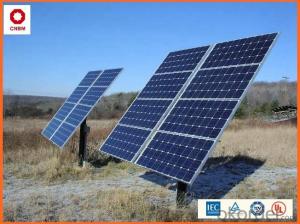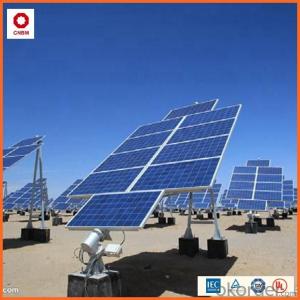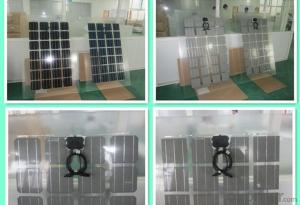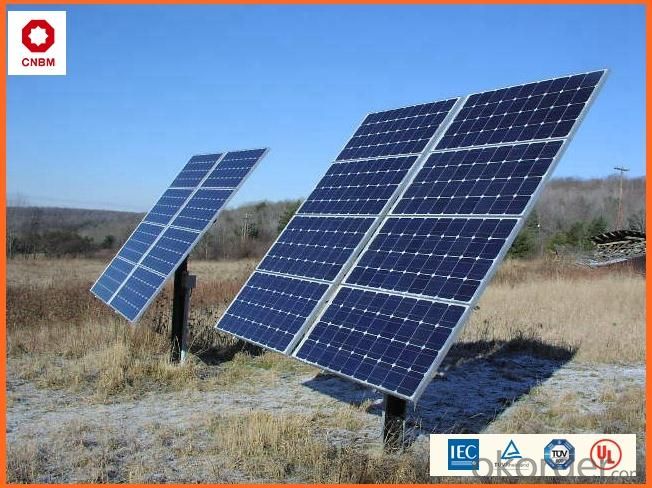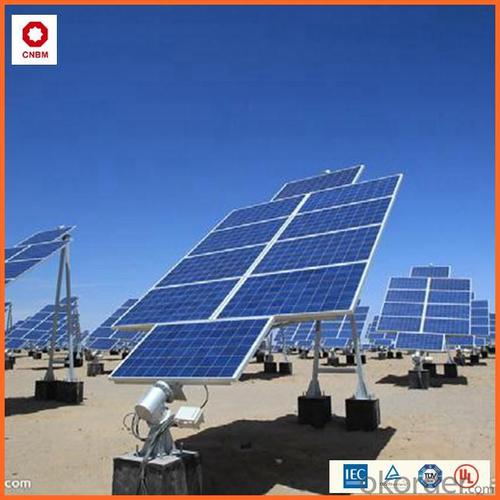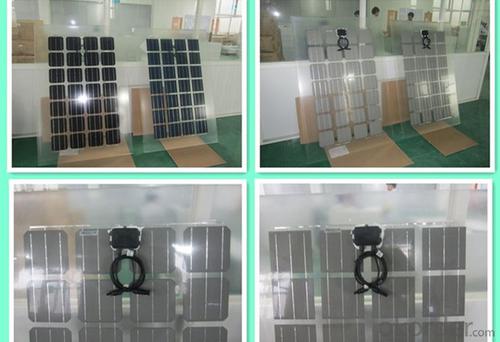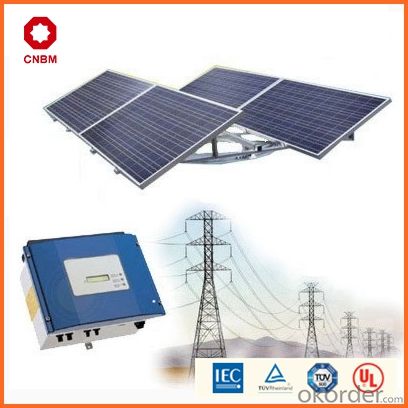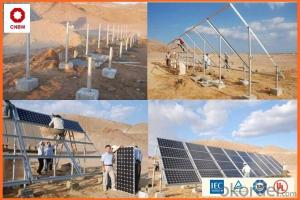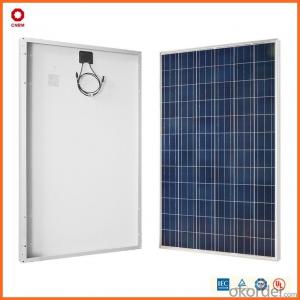Agl Solar Energy Systems 100w Small Solar Panels in Stock China Manufacturer
- Loading Port:
- China main port
- Payment Terms:
- TT OR LC
- Min Order Qty:
- 1 watt
- Supply Capability:
- 10000000 watt/month
OKorder Service Pledge
OKorder Financial Service
You Might Also Like
Specification
Product Description:
Hot Sale !!! Quality and Safety of Small Poly Solar Panel 5w~150w
1. Rigorous quality control meets the highest international standards.
2. High-transmissivity low-iron tempered glass, strong aluminium frame.
3. Using UV-resistant silicon.
4. IS09001/14001/CE/TUV/UL
Warranties of Small Poly Solar Panel 35~85w
1. 10 years limited product warranty
2. 15 years at 90% of the minimal rated power output
3. 25 years at 80% of the minimal rated power output
Specification
Characteristics of Poly solar panels CNBM (245-320W) | |||||
Max Power Voltage Vmp(V) | 30.3 | 30.8 | 31.1 | 31.4 | 31.85 |
Max Power Current Imp(A) | 7.60 | 7.64 | 7.73 | 7.81 | 7.85 |
Open Circuit Voltage Voc(V) | 36.1 | 36.6 | 37 | 37.3 | 37.68 |
Short Circuit Current Isc(A) | 8.50 | 8.55 | 8.65 | 8.75 | 8.85 |
Max Power Pm(W) | 230W | 235W | 240W | 245W | 250W |
Temperature Coefficient of Cells Poly solar panels CNBM (245-320W) | |
NOCT | 45± 2 |
Temperature Coeffucients of Isc | 0.0492 |
Temperature Coeffucients of Voc | -0.3374 |
Temperature Coeffucients of Voc | -0.4677 |
Mechanical Data of Poly solar panels CNBM (245-320W) | |
Dimension | 1638 × 982 × 40 mm |
Weight | 19.5 kg |
No. of Cells and Connections | 60 (6 ×10) |
Tolerance | 0 ~ + 5 W |
Cell | Monocrystalline Cell 156 × 156 mm |
Packing | 624 Pcs/40ft(H) Container |
Limits of Poly solar panels CNBM (245-320W) | |
Operating Temperature | -40 to +85 |
Storage Temperature | -40 to +85 |
Max System Voltage | 1000VDC(IEC) / 600VDC(UL) |
Features of our products:
• High conversion efficiency mono/poly-crystalline amorphous silicon solar cells
• Modules incorporate high performance bypass diodes to minimize the power drop caused by shading
• High transmittance, low-iron tempered glass
• High performance EVA encapsulant to prevent destroying and water.
• AI frame: without screw, corner connection. 8 holes on the frame can be installed easily
• Good performance of preventing from atrocious weather such as wind and hails
• Certifications: CE IEC TUV VDE UL, Class I
• 10 years 90% power output warranty

Shipping of Small Poly Solar Panel 35~85w
By Sea | Delivery from Shanghai or Ningbo seaport |
By Air | Departure from Shanghai Pudong Airport |
By Express | Post by DHL, EMS, UPS, TNT. |
Features of our products:
• High conversion efficiency mono/poly-crystalline amorphous silicon solar cells
• Modules incorporate high performance bypass diodes to minimize the power drop caused by shading
• High transmittance, low-iron tempered glass
• High performance EVA encapsulant to prevent destroying and water.
• AI frame: without screw, corner connection. 8 holes on the frame can be installed easily
• Good performance of preventing from atrocious weather such as wind and hails
• Certifications: CE IEC TUV VDE UL, Class I
• 10 years 90% power output warranty
As a professional Solar Panel manufacturer and Supplier in China, we have our customers come around the whole world and our specialization has got a worldwide recognition. Meanwhile, with our superior quality, competitive price, prompt and excellent service, As main role in trade section of CNBM Group, CNBM International Corporation supplies products including Monocrystalline Solar Panel, Polycrystalline Solar Panel ( multicrystalline silicon Solar Panel) have received and enjoyed famous reputation in many countries and regions in the world.
- Q: How do solar energy systems affect the carbon footprint?
- Solar energy systems significantly reduce carbon footprint. They generate electricity by harnessing the sun's energy, which is a clean and renewable source. This eliminates the need for fossil fuels, such as coal and natural gas, that release harmful carbon dioxide emissions when burned. By using solar energy, we can minimize greenhouse gas emissions and combat climate change.
- Q: What are the advantages and disadvantages of small-scale solar power generation system?
- There are intermittent and random ground application, power generation and climatic conditions in the night or rainy days have little or no power; lower power density, under standard conditions, the solar radiation intensity on the ground received for 1000W/M^2. Large scale use, the need to occupy a larger area; the price is still more expensive, for conventional power generation 3~15 times, the initial investment is high.
- Q: Can solar energy systems be used for powering off-grid sustainable communities?
- Yes, solar energy systems can definitely be used for powering off-grid sustainable communities. Solar panels can generate electricity by converting sunlight into usable energy, providing a reliable and renewable source of power. These systems can be installed in remote areas where access to the conventional power grid is limited or non-existent, allowing off-grid communities to become self-sufficient and sustainable. Solar energy is clean, emission-free, and requires minimal maintenance, making it an ideal solution for powering off-grid communities and promoting sustainable development.
- Q: What is the role of solar charge controllers in regulating the charging of batteries?
- The role of solar charge controllers is to regulate the charging of batteries by controlling the flow of electricity from the solar panels to the batteries. They ensure that the batteries are charged efficiently and safely by monitoring and adjusting the voltage and current levels. This helps prevent overcharging, which could damage the batteries, and also prevents over-discharging, which could lead to reduced battery life. Solar charge controllers also provide protection against voltage spikes, reverse current flow, and other potential issues, ensuring optimal charging and prolonging the lifespan of the batteries.
- Q: Can solar energy systems be used for greenhouse heating?
- Yes, solar energy systems can be used for greenhouse heating. By harnessing the power of the sun, solar panels can generate electricity or heat water that can be used to warm the greenhouse. This helps in maintaining optimal temperatures for plant growth and reducing reliance on conventional heating methods, making it an eco-friendly and cost-effective solution.
- Q: What is the role of solar energy in achieving energy independence?
- Solar energy plays a crucial role in achieving energy independence by providing a clean, renewable, and abundant source of power. It reduces our dependence on fossil fuels, mitigates climate change, and promotes sustainability. Solar power empowers individuals, communities, and even entire nations to generate their own electricity, reducing reliance on imported energy and creating a more resilient and self-sufficient energy system.
- Q: Can solar energy systems be used in areas with limited access to training programs?
- Yes, solar energy systems can be used in areas with limited access to training programs. While training programs can provide valuable knowledge and skills in installing and maintaining solar energy systems, there are alternative resources available. Online courses, instructional videos, and manuals can offer self-learning opportunities for individuals in areas with limited access to training programs. Additionally, local technicians with expertise in solar energy can be trained to support the installation and maintenance of these systems, ensuring the utilization of solar energy even in areas with limited training resources.
- Q: Are there any ongoing monitoring requirements for solar energy systems?
- Solar energy systems have ongoing monitoring requirements to ensure efficient and effective operation. Monitoring is crucial for identifying and addressing any potential issues or malfunctions promptly. Ongoing monitoring involves tracking various aspects of the system's performance, such as energy production, system uptime, and deviations from expected outputs. This can be accomplished using different monitoring tools and technologies, including real-time monitoring software, data loggers, or remote monitoring systems. Furthermore, specific monitoring requirements may exist in certain jurisdictions or incentive programs to ensure compliance with regulations or eligibility criteria. Regular monitoring is essential for maximizing the benefits of solar energy systems and ensuring their long-term performance and durability.
- Q: Are there any financial incentives for installing solar energy systems?
- Yes, there are several financial incentives available for installing solar energy systems. These incentives vary by country and region but can include tax credits, grants, rebates, and net metering programs. Additionally, installing solar panels can help reduce electricity bills and increase property value, resulting in long-term financial benefits.
- Q: Are there any financing options available for solar energy systems?
- Yes, there are several financing options available for solar energy systems. Some common options include solar loans, solar leases, power purchase agreements (PPAs), and government incentives such as tax credits and grants. These options can make solar energy more affordable and accessible to homeowners and businesses.
Send your message to us
Agl Solar Energy Systems 100w Small Solar Panels in Stock China Manufacturer
- Loading Port:
- China main port
- Payment Terms:
- TT OR LC
- Min Order Qty:
- 1 watt
- Supply Capability:
- 10000000 watt/month
OKorder Service Pledge
OKorder Financial Service
Similar products
Hot products
Hot Searches
Related keywords

